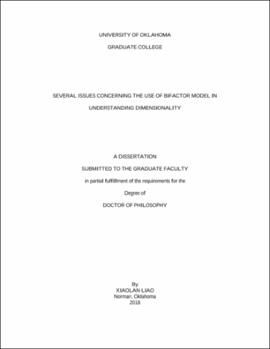| dc.description.abstract | The goals of the study are to investigate the use of bifactor models in understanding dimensionality and to demonstrate several issues that arise from its applications. The bifactor analysis is available for about 80 years, and it is lately argued that the bifactor model is superior to its competitors in many aspects of studying dimensionality. The bifactor model is currently widely applied to examine both old and new concepts against second-order factor model/multiple factor models in many fields. Despite its widespread use and many advantages, the bifactor analysis is not well understood, and the latest techniques developed for it are not endorsed by applied researchers. The misunderstandings had led to both methodological challenges and practical erroneousness which resulted in fallacious conclusions. The present study attempts to demonstrate several critical issues concerning bifactor favoring model fit bias, three exploratory bifactor analytics (S-L transformation, J-B analytics, and target rotation), and oblique versus orthogonal bifactor representations by using three real data. Substantively, the present study will potentially advance the understandings of the three constructs under review as well as their relations to external variables. Methodologically, the present research broadens the literature in clarifying the current issues regarding bifactor analysis, and hopefully, this study will enlighten the applied researchers on the latest techniques.
Results from the current study showed that the confirmatory bifactor model has a better fit than its nested second-order factor model or multiple factor models across the three studies which conform with previous findings. Whether a bifactor model will always fit better is still under investigation. Several researchers have dedicated their work to identify the source of the bias, and a consolidated explanation is yet to find. However, it is warned that researchers shall not rely on model fit as the sole criterion in determining the champion between the two. Results from the first study also showed that the three exploratory bifactor analytics do not agree in the presence of cross-loadings. Specifically, unexpected patterns are observed with the orthogonal J-B solution and the oblique target rotation solution. The former has produced a distorted group factor with which three out of 6 of its loadings are smaller than .30, and two negative loadings cross-loaded. The latter has generated a weak and partially defined general factor with which seven out of 24 of its loadings are smaller than .40 and three of them lower than .30. The results might indicate that orthogonal J-B analytic and oblique target rotation methods are inadequate at recovering complexities (e.g., the presence of cross-loaded items). With the second study, a surprising factor pattern is observed, in which a second general factor runs through all the items but with half negative loadings. This unexpected pattern might represent a special case of the “group factor collapsing onto general factor” problem that is specific to the J-B analytic.
The current findings also suggest that oblique solution tends to introduce a higher level general factor to account for the group factor intercorrelations which complicates the model and results in difficulties in interpretation. The bifactor model is found especially useful with two-dimensional data where a second-order model is not identifiable. The model-based indices such as omega hierarchical, ECV, FD, and H are helpful in assessing the strength of the general factor, and it is recommended to report them in applied researches. Worth mentioning is that they might be subject to model misspecifications. Besides, item cluster analysis seems to be useful in discovering departure from the perfect independent structure of multidimensional data. It is recommended to perform exploratory factor analysis as a preliminary exploration before conducting the exploratory bifactor analysis. Recommendations and insights for future studies follow discussions on the issues. | en_US |
